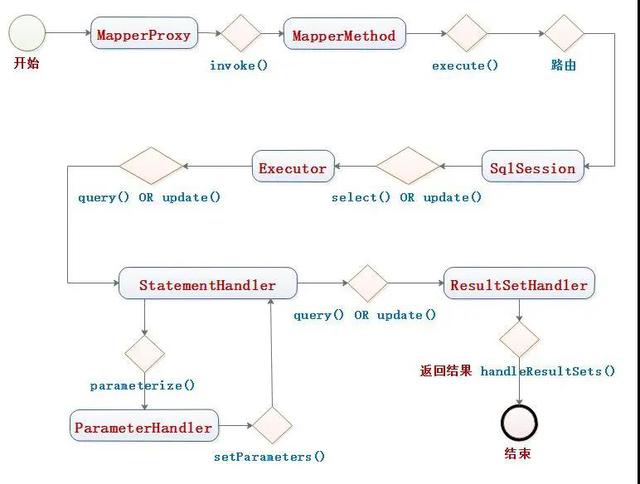Mybatis是如何执行一条SQL命令的
Mybatis中的Sql命令 , 在枚举类SqlCommandType中定义的 。
 文章插图
文章插图
下面 , 我们以Mapper接口中的一个方法作为例子 , 看看Sql命令的执行完整流程 。
 文章插图
文章插图
参数RowBounds和ResultSetHandler是可选参数 , 表示分页对象和自定义结果集处理器 , 一般不需要 。
一个完整的Sql命令 , 其执行的完整流程图如下:
 文章插图
文章插图
对于上面的流程图 , 如果看过前面的文章的话 , 大部分对象我们都比较熟悉了 。 一个图 , 就完整展示了其执行流程 。
MapperProxy的功能:
1. 因为Mapper接口不能直接实例化 , MapperProxy的作用 , 就是使用JDK动态代理功能 , 间接实例化Mapper的proxy对象 。 可参看系列的第二篇 。
2. 缓存MapperMethod对象 。
private final Map
@Override
public Object invoke(Object proxy, Method method, Object[] args) throws Throwable {
if (Object.class.equals(method.getDeclaringClass())) {
try {
return method.invoke(this, args);
} catch (Throwable t) {
throw ExceptionUtil.unwrapThrowable(t);
}
}
// 投鞭断流
final MapperMethod mapperMethod = cachedMapperMethod(method);
return mapperMethod.execute(sqlSession, args);
}
// 缓存MapperMethod
private MapperMethod cachedMapperMethod(Method method) {
MapperMethod mapperMethod = methodCache.get(method);
if (mapperMethod == null) {
mapperMethod = new MapperMethod(mapperInterface, method, sqlSession.getConfiguration());
methodCache.put(method, mapperMethod);
}
return mapperMethod;
}
MapperMethod的功能:
1. 解析Mapper接口的方法 , 并封装成MapperMethod对象 。
2. 将Sql命令 , 正确路由到恰当的SqlSession的方法上 。
public class MapperMethod {
// 保存了Sql命令的类型和键id
private final SqlCommand command;
// 保存了Mapper接口方法的解析信息
private final MethodSignature method;
public MapperMethod(Class mapperInterface, Method method, Configuration config) {
this.command = new SqlCommand(config, mapperInterface, method);
this.method = new MethodSignature(config, method);
}
// 根据解析结果 , 路由到恰当的SqlSession方法上
public Object execute(SqlSession sqlSession, Object[] args) {
Object result;
if (SqlCommandType.INSERT == command.getType()) {
Object param = method.convertArgsToSqlCommandParam(args);
result = rowCountResult(sqlSession.insert(command.getName(), param));
} else if (SqlCommandType.UPDATE == command.getType()) {
Object param = method.convertArgsToSqlCommandParam(args);
result = rowCountResult(sqlSession.update(command.getName(), param));
} else if (SqlCommandType.DELETE == command.getType()) {
Object param = method.convertArgsToSqlCommandParam(args);
result = rowCountResult(sqlSession.delete(command.getName(), param));
- 红米K40渲染图曝光:居中挖孔+后置四摄,这外观你觉得如何?
- 奋斗|该如何看待拼多多员工猝死:鼓励奋斗,也要保护好奋斗者
- 装机点不亮 如何简易排查硬件问题?
- 虾米音乐宣布关停!我的歌单如何导入QQ音乐、网易云音乐?
- 人脸识别设备主板如何选型 软硬整合大幅缩短开发时间
- 高通公司宣布任命安蒙为候任首席执行官
- Mini-LED产品效果究竟如何?
- 专家介绍如何判断智能手机被入侵:运行速度变慢、电池消耗过快以及卡顿
- 最便宜的骁龙888手机?红米K40曝光:这外观如何?
- 广色域还不够 投影如何实现精准色彩还原?
